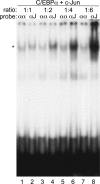AP-1 protein induction during monopoiesis favors C/EBP: AP-1 heterodimers over C/EBP homodimerization and stimulates FosB transcription
- PMID: 21543584
- PMCID: PMC3177697
- DOI: 10.1189/jlb.0111043
AP-1 protein induction during monopoiesis favors C/EBP: AP-1 heterodimers over C/EBP homodimerization and stimulates FosB transcription
Abstract
AP-1 proteins heterodimerize via their LZ domains to bind TGACGTCA or TGACTCA, whereas C/EBPs dimerize to bind ATTGCGCAAT. We demonstrate that intact C/EBPα also heterodimerizes with c-Jun or c-Fos to bind a hybrid DNA element, TGACGCAA, or more weakly to TGATGCAA. A 2:1 ratio of c-Jun:C/EBPα or c-Fos:C/EBPα was sufficient for preferential binding. Semiquantitative Western blot analysis indicates that the summation of c-Jun, JunB, and c-Fos levels in differentiating myeloid cells is similar to or exceeds the entirety of C/EBPα and C/EBPβ, indicating the feasibility of heterodimer formation. Induction of AP-1 proteins during monocytic differentiation favored formation of C/EBP:AP-1 heterodimers, with C/EBPα homodimers more evident during granulopoiesis. Approximately 350 human and 300 murine genes contain the TGACGCAA motif between -2 kb and +1 kb of their transcription start sites. We focused on the murine Fosb promoter, which contains a C/EBP:AP-1 cis element at -56 and -253, with the hFOSB gene containing an identical site at -253 and a 1-bp mismatch at -56. C/EBPα:AP-1 heterodimers bound either site preferentially in a gel-shift assay, C/EBPα:c-Fos ER fusion proteins induced endogenous Fosb mRNA but not in the presence of CHX, C/EBP and AP-1 proteins bound the endogenous Fosb promoter, mutation of the -56 cis element reduced reporter activity fivefold, and endogenous FosB protein was expressed preferentially during monopoiesis versus granulopoiesis. Increased expression of Jun/Fos proteins elevates C/EBP:AP-1 heterodimer formation to potentially activate novel sets of genes during monopoiesis and potentially during other biologic processes.
Figures







Comment in
-
Editorial: granulopoiesis versus monopoiesis: a consequence of transcription factors dancing with the right partners.J Leukoc Biol. 2011 Oct;90(4):637-8. doi: 10.1189/jlb.0411187. J Leukoc Biol. 2011. PMID: 21965310 Free PMC article.
Similar articles
-
Editorial: granulopoiesis versus monopoiesis: a consequence of transcription factors dancing with the right partners.J Leukoc Biol. 2011 Oct;90(4):637-8. doi: 10.1189/jlb.0411187. J Leukoc Biol. 2011. PMID: 21965310 Free PMC article.
-
C/EBP alpha:AP-1 leucine zipper heterodimers bind novel DNA elements, activate the PU.1 promoter and direct monocyte lineage commitment more potently than C/EBP alpha homodimers or AP-1.Oncogene. 2008 Apr 24;27(19):2772-9. doi: 10.1038/sj.onc.1210940. Epub 2007 Nov 19. Oncogene. 2008. PMID: 18026136 Free PMC article.
-
Assessment of the role of activator protein-1 on transcription of the mouse steroidogenic acute regulatory protein gene.Mol Endocrinol. 2004 Mar;18(3):558-73. doi: 10.1210/me.2003-0223. Epub 2003 Dec 12. Mol Endocrinol. 2004. PMID: 14673133
-
C/EBPalpha induces PU.1 and interacts with AP-1 and NF-kappaB to regulate myeloid development.Blood Cells Mol Dis. 2007 Nov-Dec;39(3):340-3. doi: 10.1016/j.bcmd.2007.06.010. Epub 2007 Jul 31. Blood Cells Mol Dis. 2007. PMID: 17669672 Free PMC article. Review.
-
Regulation of granulocyte and monocyte differentiation by CCAAT/enhancer binding protein alpha.Blood Cells Mol Dis. 2003 Nov-Dec;31(3):338-41. doi: 10.1016/s1079-9796(03)00135-9. Blood Cells Mol Dis. 2003. PMID: 14636649 Review.
Cited by
-
Gfi1-Mediated Repression of c-Fos, Egr-1 and Egr-2, and Inhibition of ERK1/2 Signaling Contribute to the Role of Gfi1 in Granulopoiesis.Sci Rep. 2019 Jan 24;9(1):737. doi: 10.1038/s41598-018-37402-z. Sci Rep. 2019. PMID: 30679703 Free PMC article.
-
Regulation of cytochrome P450 2e1 expression by ethanol: role of oxidative stress-mediated pkc/jnk/sp1 pathway.Cell Death Dis. 2013 Mar 21;4(3):e554. doi: 10.1038/cddis.2013.78. Cell Death Dis. 2013. PMID: 23519123 Free PMC article.
-
Absence of myeloid Klf4 reduces prostate cancer growth with pro-atherosclerotic activation of tumor myeloid cells and infiltration of CD8 T cells.PLoS One. 2018 Jan 11;13(1):e0191188. doi: 10.1371/journal.pone.0191188. eCollection 2018. PLoS One. 2018. PMID: 29324844 Free PMC article.
-
Editorial: granulopoiesis versus monopoiesis: a consequence of transcription factors dancing with the right partners.J Leukoc Biol. 2011 Oct;90(4):637-8. doi: 10.1189/jlb.0411187. J Leukoc Biol. 2011. PMID: 21965310 Free PMC article.
-
Mocap: large-scale inference of transcription factor binding sites from chromatin accessibility.Nucleic Acids Res. 2017 May 5;45(8):4315-4329. doi: 10.1093/nar/gkx174. Nucleic Acids Res. 2017. PMID: 28334916 Free PMC article.
References
-
- Landschulz W. H., Johnson P. F., McKnight S. L. (1989) The DNA binding domain of the rat liver nuclear protein C/EBP is bipartite. Science 243, 1681–1688 - PubMed
-
- Miller M., Shuman J. D., Sebastian T., Dauter Z., Johnson P. F. (2003) Structural basis for DNA recognition by the basic region leucine zipper transcription factor C/EBPα. J. Biol. Chem. 278, 15178–15184 - PubMed
-
- Mechta-Grigoriou F., Gerald D., Yaniv M. (2001) The mammalian Jun proteins: redundancy and specificity. Oncogene 20, 2378–2389 - PubMed
Publication types
MeSH terms
Substances
Grants and funding
LinkOut - more resources
Full Text Sources
Miscellaneous

